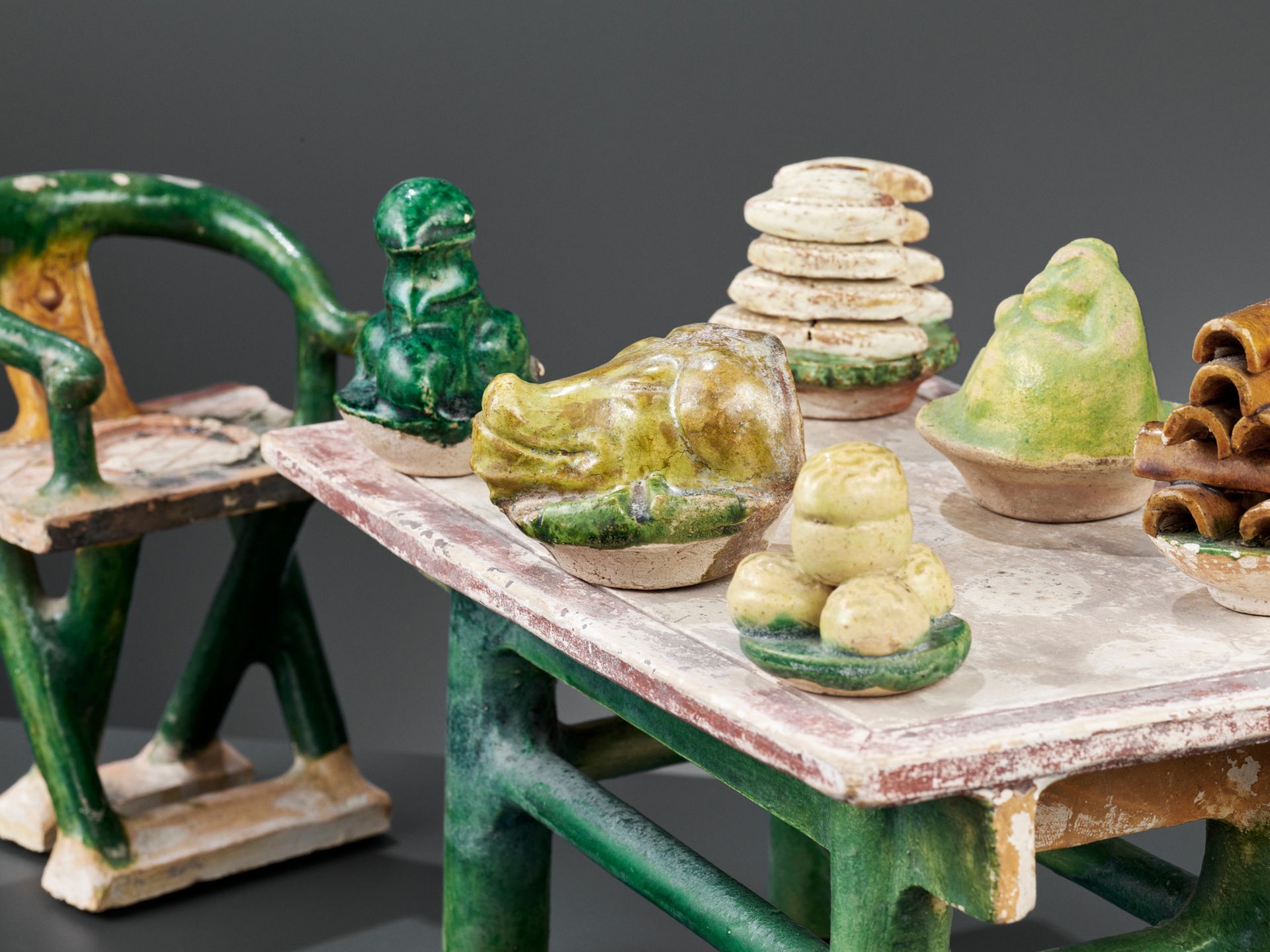Description
A SET OF SANCAI-GLAZED POTTERY FURNITURE AND OFFERINGS, MING DYNASTY
A SET OF SANCAI-GLAZED POTTERY FURNITURE AND OFFERINGS, MING DYNASTY China, 1368-1644. Comprising two horseshoe-back folding armchairs (jiao yi) and an altar table with six separate trays of offerings including a pig’s head, a chicken, peaches and nuts, all variously glazed in green, amber, and cream, and some pieces with additional dark red pigment. (9) Provenance: A notable private collector in Kensington, London, United Kingdom. Condition: Old wear and firing flaws, such as kiln grit, firing cracks, and glaze recesses. Small losses. The chairs with minor old repairs and touchups. Overall as expected, commensurate with age and presenting very well. Weight: 2,157 g (the table), 501.8 g and 535.2 g (the chairs), 757 g (the offerings) Dimensions: Size 28.2 x 17 x 13.4 cm (the table), Height 17.2 cm and 17.4 cm (the chairs) Expert’s note: According to Jessica Harrison-Hall, Head of the China section, Curator of Chinese Ceramics and Decorative Arts at the British Museum, related “models of folding armchairs made in metal, stone and wood have been excavated from middle and late Ming tombs”. Such chairs appear frequently to have been placed in these tombs, belonging to members of the aristocracy and scholarly elite. “Two models of folding armchairs, one of bronze and one of tin were excavated in the Ding Ling, the tomb of the Wanli emperor (1573-1619). Another similar model of a folding armchair with a textile covering, carved from stone, was excavated from a tomb at Tongliang county, Sichuan.” This chair was discovered near a small rectangular table laden with an assortment of model food dishes, which suggests that folding armchairs were used for dining. Literature comparison: Compare a closely related horseshoe-back folding armchair, dated circa 1550-1600, in the collection of the British Museum, museum number 1937,0716.135. Auction result comparison: Compare a related group, also with Sancai glaze and dated to the Ming dynasty, at Christie’s New York in Fine Chinese Ceramics, Paintings and Works of Art on 21 September 2000, lot 305, sold for USD 4,465. 5% or 13% VAT will be added to the hammer price additional to the buyer’s premium – only for buyers within the EU. 明代一組三彩祭祀用品 中國,1368-1644年。兩把馬蹄形折疊扶手椅(交椅)和一張祭桌,六個獨立的供品托盤,托盤中有一個豬頭、一隻雞、桃子和堅果,所有這些都用綠色、黃色和白色釉,還有一些深紅色。 (9) 來源:英國倫敦知名私人收藏 品相:舊時磨損和燒製缺陷,如窯灰、裂紋、釉面凹陷和小缺損。椅子有輕微維修和修飾。總體符合預期,與年齡相符。 重量:桌子2,157克,椅子分別為501.8克與535.2克,祭品757 克 尺寸:桌子28.2 x 17 x 13.4 厘米,椅子分別高 17.2 厘米與17.4 厘米 專家注釋:據大英博物館中國部負責人、中國陶瓷與裝飾藝術館館長Jessica Harrison-Hall介紹,“明中後期墓葬中出土了金屬、石頭和木材製成的折疊扶手椅模型”。這些椅子似乎經常被放置在這些墓中,屬於貴族和文人的專用。“在萬曆皇帝(1573-1619)陵墓中出土了兩種折疊扶手椅,一種是青銅,一種是錫。另一種類似的折疊扶手椅模型,由石頭雕刻而成,帶有紡織覆蓋物,是從四川銅梁縣的一座墓葬中出土的。” 這把椅子是在一個小長方形桌子附近發現的,桌子上放著各種各樣的食物模型,這表明折疊扶手椅是用來吃飯時使用的。 拍賣結果比較:比較一件相近明代三彩組,見紐約佳士得 Fine Chinese Ceramics, Paintings and Works of Art 2000年9月21日 lot 305, 售價USD 4,465。
745
A SET OF SANCAI-GLAZED POTTERY FURNITURE AND OFFERINGS, MING DYNASTY
You may also like
